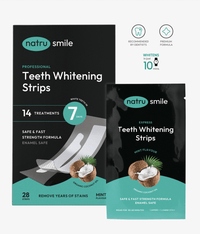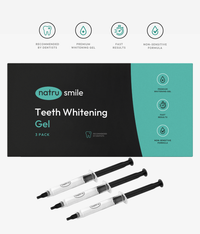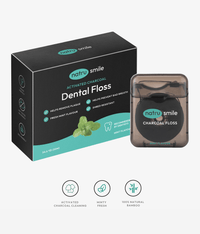
All products are certified by dental expert Dr. Greg Grillo
Cavities are unwelcome guests that can invade your mouth and cause trouble and discomfort if left unattended. They can eat away at your tooth enamel, cause pain and sensitivity, and even lead to tooth loss if not treated.
But, fear not! This comprehensive guide is here to help you fight back and keep your teeth healthy and bright. It's time to take control of your dental health and say goodbye to those pesky cavities once and for all.
From managing the pain to discovering the latest advancements in cavity treatment and prevention, we've got all the information in this article you need to learn how to get rid of cavities and maintain your beautiful smile.
So, let's sink our teeth into this guide and equip ourselves with the knowledge and tools to combat those pesky cavities.
What Is A Cavity? Comprehensive Overview
Picture your tooth like a fortress, with the tough outer layer, known as enamel, protecting the delicate inner layers. But just like a fortress can fall under siege, so can your tooth when harmful invaders attack.
That's where cavities come in.
A cavity, also known as dental caries or tooth decay, is the result of the prolonged erosion of tooth enamel by acid produced by harmful bacteria in your mouth. The acid breaks down the enamel and forms a hole in your tooth.
If left unchecked, cavities can progress through the different layers of your tooth, eventually leading to severe pain, tooth loss, and even the spread of infection to other parts of your body.
The Anatomy Of A Tooth
To better understand cavities, it's essential to know the basic structure of a tooth:
- Enamel: The outermost layer of the tooth, made of the hardest substance in the human body. Enamel protects the tooth from daily wear and tear.
- Dentin: The second layer, a sensitive, porous material that provides support to the enamel. Dentin is responsible for transmitting sensations from the tooth surface to the nerves within the tooth.
- Pulp: The innermost layer, containing nerves and blood vessels that provide nutrients and sensation to the tooth. The pulp is vital for tooth development and overall health.
What Causes Cavities?
Cavities primarily form due to plaque, a sticky substance containing bacteria that accumulates on teeth. When you consume foods high in sugar and starch, the bacteria in plaque produce acids that attack tooth enamel.
Over time, the acids from these foods cause cavities by breaking down the enamel.
The Cavity Formation Process
Understanding how cavities form is crucial to preventing them from occurring in the first place.
This section will provide a comprehensive overview of the cavity formation process, including the different stages involved and the factors that contribute to their development.
By gaining a deeper understanding of the process, you can take the necessary steps to protect your teeth and maintain good oral health.
- Plaque formation: Bacteria in the mouth combine with food particles to form plaque on the tooth surface.
- Acid production: When you consume sugary or starchy foods, bacteria in plaque produce acids.
- Enamel demineralization: The acids attack tooth enamel, causing minerals to leach out of the enamel, creating microscopic holes.
- Cavity formation: Over time, the demineralization process leads to the formation of larger holes or cavities in the tooth.
Risk Factors For Cavities
There are certain factors that can make you more susceptible to tooth decay, but by understanding these risk factors, you can take steps to protect your dental health.
The main risk factors are:
- Poor oral hygiene: Inadequate brushing and flossing can lead to plaque buildup and increase the risk of cavities.
- Frequent snacking or sipping on sugary beverages: Constant exposure to sugar and acid increases the risk of enamel demineralization and cavity formation.
- Acid reflux disease: Gastroesophageal reflux disease (GERD) can bring stomach acids into the mouth, causing tooth enamel to erode.
- Dry mouth: Saliva helps neutralize acids and wash away food particles. A lack of saliva, or dry mouth, can increase the risk of cavities.
- Eating disorders: Conditions like anorexia and bulimia can lead to malnutrition and increased acid exposure, both of which can contribute to tooth decay.
- Tobacco use: Smoking or using smokeless tobacco can reduce saliva production and promote plaque formation, increasing the risk of cavities.
- Genetics: Some people may be genetically predisposed to developing cavities due to factors such as enamel strength and saliva composition.
By understanding the causes and risk factors associated with cavities, you can take proactive steps to maintain good oral health and reduce your risk of developing dental caries.
Regular dental check-ups and cleanings, recognizing cavities symptoms, and following a balanced diet and proper oral care routine, can help keep your teeth healthy and cavity-free.
5 Ways To Fix Cavities At The Dentist
If you have been diagnosed with a cavity, it is important to schedule a dental appointment promptly to avoid the progression of decay. Fortunately, dental professionals offer several treatment options to repair and restore your damaged teeth.
In this section, we will explore five common ways on how to get rid of cavities at the dentist, including their benefits and drawbacks.
By understanding your options, you can make an informed decision about which treatment is right for you.
1. Fluoride Treatments
Fluoride is a mineral that plays a crucial role in maintaining strong, healthy teeth. In the early stages of tooth decay, professional fluoride treatments can help repair the damage and prevent cavities from forming.
How Fluoride Treatments Work
Fluoride treatments are incredibly easy, and your dentist will be able to get them done in just a few simple steps.
- The dentist will apply a high-concentration fluoride gel, foam, or varnish to your teeth.
- The fluoride helps to remineralize and strengthen the tooth enamel, as well as is known for its teeth whitening abilities.
- The treatment is quick, painless, and can be completed during a routine dental check-up.
Benefits Of Fluoride Treatments
- Can halt the progression of early tooth decay
- Strengthen tooth enamel, making it more resistant to acid attacks
- Can help prevent the need for more invasive dental treatments
2. Crowns
A dental crown, also known as a tooth cap, is a prosthetic device that covers the entire visible part of a tooth above the gum line.
This restoration method is commonly used when a tooth has experienced severe decay, damage, or fracture that cannot be treated with a filling. The crown is designed to fit over the damaged tooth, restoring its shape, size, strength, and appearance.
Crowns can be made from a variety of materials, including porcelain, ceramic, metal, or a combination of these materials, and can be customized to match the color and shape of your natural teeth.
Benefits Of Dental Crowns
- Provide structural support for weakened teeth
- Protect teeth from further decay or damage
- Improve the appearance of discolored or misshapen teeth
3. Fillings
Dental fillings are one of the most common and straightforward methods of treating cavities. This procedure involves removing the decayed or damaged portion of the tooth and replacing it with a filling material such as composite resin, porcelain, or amalgam.
Fillings not only prevent further damage to the tooth but also help restore its function and prevent bacteria from accumulating in the cavity.
Types Of Dental Fillings
- Amalgam: A durable and cost-effective silver-colored material
- Composite resin: A tooth-colored material that blends with your natural teeth
- Porcelain: A tooth-colored, durable material often used for more visible teeth
Benefits Of Dental Fillings
- Repair cavities and prevent further tooth decay
- Restore the function and appearance of damaged teeth
- Can last for several years with proper care
4. Root Canals
A root canal is a dental procedure that can be necessary when a cavity progresses to the point where it has reached the innermost part of the tooth, known as the pulp. The pulp is made up of nerves, blood vessels, and other soft tissues that help the tooth grow and develop.
When the pulp becomes infected or inflamed due to decay, injury, or other factors, it can cause severe pain, sensitivity, and swelling.
Root Canal Procedure
- Your dentist will numb the area around the tooth.
- They will then remove the infected pulp from the tooth's inner chamber.
- The tooth's chamber and root canals are thoroughly cleaned and disinfected.
- Finally, the tooth is sealed with a filling or crown to prevent reinfection.
Benefits Of Root Canals
- Can save a severely decayed tooth from extraction
- Alleviate pain and discomfort caused by infection
- Prevent the spread of infection to surrounding teeth and tissues
5. Tooth Extractions
Tooth extraction is a dental procedure where a tooth is removed from its socket in the jawbone. This procedure is typically considered as the last resort when other treatments are not possible, and the tooth cannot be saved.
The tooth may be damaged beyond repair due to severe decay, trauma, gum disease, or infection.
Tooth Extraction Procedure
- The dentist will numb the area surrounding the tooth.
- They will then use dental instruments to carefully loosen and remove the tooth.
- The extraction site may be sutured to aid in healing.
Tooth Replacement Options
After a tooth extraction, your dentist may recommend a tooth replacement solution, such as:
- Dental implants: A titanium post is surgically placed into the jawbone, and a crown is attached to mimic a natural tooth
- Dental bridges: A false tooth is anchored to the adjacent healthy teeth using crowns or metal frameworks
- Partial dentures: A removable appliance that holds one or more false teeth in place, attached to a gum-colored base
Benefits Of Tooth Extractions
- Remove a severely decayed or damaged tooth that cannot be saved
- Alleviate pain and discomfort associated with the affected tooth
- Prevent the spread of infection to surrounding teeth and tissues
How To Manage Your Cavity Pain
Managing cavity pain can make a significant difference in your day-to-day life. Here are some practical tips to help you alleviate and control the discomfort caused by cavities
Schedule A Dentist Appointment
- Prioritize visiting the dentist as soon as you suspect a cavity
- Early treatment helps prevent further damage and reduces pain
- Regular dental check-ups can identify potential issues before they become painful
Adjust Your Diet
Sensitive teeth due to cavities may react painfully to certain foods and beverages:
- Avoid hot and cold food items, as they can exacerbate sensitivity
- Limit sugary and acidic foods, which can further weaken tooth enamel
- Opt for softer foods that are easier to chew
Use Over-the-Counter Medications
Over-the-counter medications can provide temporary relief from cavity pain:
- Anti-inflammatory medications like Advil (ibuprofen) or Aleve (naproxen) help manage pain and inflammation
- Tylenol (acetaminophen) can also provide pain relief
- Follow the recommended dosages and consult with a healthcare professional if you are unsure
Consider Natural Remedies
Some natural remedies may offer temporary relief from cavity pain:
- Eugenol, a natural pain reliever found in clove oil, can be applied to the affected tooth using a cotton swab
- Avoid direct contact with the gums, as it may cause irritation
- Consult with your dentist before using any natural remedies for cavity pain
Maintain Good Oral Hygiene
Proper oral hygiene is crucial to prevent further plaque buildup and minimize pain:
- Gently brush your teeth at least twice a day, using a soft-bristled toothbrush
- Floss daily to remove food particles and plaque from between teeth
- Rinse with an alcohol-free, antimicrobial mouthwash to keep your mouth clean and fresh
Other Pain Management Techniques
Some additional methods for managing cavity pain include:
- Applying a cold compress to the outside of your cheek near the painful tooth
- Using a desensitizing toothpaste designed to reduce tooth sensitivity
- Practicing relaxation techniques, such as deep breathing and meditation, to manage stress and pain
Remember, while these tips may help alleviate cavity pain, it is essential to visit your dentist for a proper evaluation and treatment to address the root cause of the issue
How Do You Make A Cavity Stop Hurting?
If you’re wondering how to get rid of cavity pain, we understand. It can be a frustrating and uncomfortable experience, but fortunately, there are several ways to alleviate it.
Applying a cold compress, using over-the-counter pain relievers, and avoiding food triggers are all ways to help fix a cavity at home and relieve the pain. However, the only definitive way to stop the pain is to have the cavity treated by a dentist.
Can A Cavity Go Away On Its Own?
No, a cavity cannot heal on its own. Once tooth decay has formed a cavity, professional dental intervention is required to repair the damage and prevent further issues.
How Long Does Cavity Pain Last?
Cavity pain can last until the cavity is treated by a dentist.
The duration of the pain varies depending on the severity of the decay and the individual's pain tolerance. Treating the cavity as soon as possible is crucial to minimize pain and prevent complications.
Cavity Prevention: Tips For Maintaining Healthy Teeth
Preventing cavities is crucial for maintaining good oral health. Follow these tips to reduce your risk of developing cavities:
- Brush your teeth at least twice a day with fluoride toothpaste
- Floss daily to remove plaque and food particles between teeth
- Rinse with a fluoride mouthwash
- Visit your dentist regularly for check-ups and cleanings
- Limit sugary snacks and drinks
- Drink tap water that contains fluoride
- Consider dental sealants, a protective coating applied to the chewing surfaces of the back teeth
- Don’t stress about cavity filling costs. If you have a cavity, it is essential to treat it before the issue creates more problems.
Can You Get Rid Of A Cavity Without A Filling?
If you suspect you have a cavity but are scared of the dentist and are wondering how to get rid of a cavity without a filling, we have some answers for you.
In the early stages of tooth decay, a dentist might be able to reverse the process with fluoride treatments or remineralization techniques. However, once a cavity has formed, a filling or other restorative treatment is typically required.
How Long Does It Take For A Cavity To Go Away?
The time it takes for a cavity to be treated depends on the severity of the decay and the chosen treatment method.
If you’re looking at how to get rid of a small cavity, it can usually be treated with a simple filling, which typically takes only one dental appointment.
Fillings, crowns, and root canals can typically be completed in one or two appointments, while more complex procedures, such as tooth extractions, may require additional healing time and follow-up appointments.
How To Get Rid Of A Cavities Smell
Cavities can not only cause pain and discomfort, but they can also lead to bad breath and an unpleasant odor.
If you have noticed a foul smell coming from your mouth, and you’re wondering how to get rid of cavity smell, it may be time to take some of these steps:
- Practice Good Oral Hygiene: The first step in getting rid of the cavity smell is to maintain proper oral hygiene. Brush your teeth twice a day, floss daily, and use mouthwash to keep your mouth clean and fresh.
- Visit Your Dentist: If the odor persists even after practicing good oral hygiene, it may be time to schedule a dental appointment. Your dentist can examine the cavity and recommend the best course of treatment.
- Use Breath Fresheners: While you are waiting for your dental appointment, you can use breath fresheners such as sugar-free gum or mints to mask the odor temporarily.
- Drink Plenty of Water: Drinking water can help flush out bacteria in your mouth, reducing the risk of odor-causing bacteria.
The Impact Of Diet On Cavity Formation
A balanced diet plays a crucial role in maintaining healthy teeth and preventing cavities. Consider incorporating the following foods and nutrients into your diet:
- Calcium-rich foods, such as dairy products, almonds, and leafy greens, which strengthen tooth enamel
- Phosphorus-rich foods, like fish, eggs, and beans, which support tooth remineralization
- Vitamin D from fish, eggs, and fortified milk or orange juice, which help absorb calcium
- Crunchy fruits and vegetables, like apples and carrots, which stimulate saliva production and help clean teeth
Also, it’s important to note that your mental health is just as important as your physical health when it comes to taking care of your teeth. Excess stress can cause cavities by affecting your lifestyle, your habits, and your immune system. So take care of yourself!
Final Thoughts
As you can see, cavities are a common dental issue that requires professional intervention.
The battle against cavities requires a combination of preventive measures, prompt treatment, and regular dental check-ups. With the knowledge and tools gained from this comprehensive guide on how to get rid of cavities, you're now equipped to tackle cavities head-on and preserve your beautiful smile.
Don't hesitate to consult with your dentist if you suspect you have a cavity, and take the necessary steps to get rid of them safely.
Now go take a bite out of those pesky cavities and let your pearly whites shine bright like a diamond!









